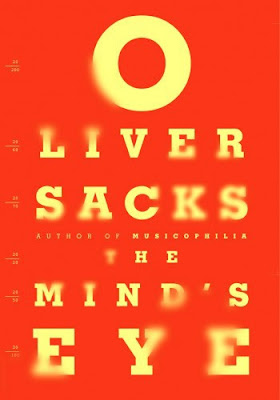Dr. Oliver Sacks was a practicing neurologist and professor who wrote a number of popular books about people afflicted with neurological disorders and/or brain damage.

Dr. Oliver Sacks
In this book Sacks relates stories about patients who developed problems with their eyes or the 'vision' areas of the brain, including loss of the ability to read, inability to recognize everday objects, and impairment of stereoscopic and/or peripheral vision. Sacks also tells a very personal story about his own eye tumor.
Sacks starts with the story of Lillian Kallir, a gifted concert pianist who slowly lost her ability to read music, then words (writing), and finally the ability to identify mundane objects like a fruit or a violin. Through it all, Lillian retained her writing skills and maintained a lively correspondence - though she couldn't read what she wrote. (I'll admit, this seems REALLY strange to me.)

Lillian Kallir
In normal life Lillian functioned, in part, by memorizing the location of objects around her. Sacks tells a story of having tea at Lillian's house and inadvertently moving a plate of biscuits, after which Lillian could no longer 'see' the biscuits - though they were still on the table. Lillian never recovered her lost abilities but was able to live a (more or less) normal life because of her musical gifts, excellent memory, and the help of her husband, friends, and doctors.

Sacks also relates stories about other individuals who lost their ability to read and/or recognize objects - usually due to a stroke or brain injury - and how they coped (or didn't) with the problem. Some patients eventually recovered their capabilities, some didn't.
Another interesting topic Sacks address is the inability of some people (including himself) to recognize faces, a condition called prosopagnosia. This problem apparently plagued Sacks for all his life. He tells one story about leaving the office of his long-time psychiatrist, then meeting a gentleman in the lobby who addressed him in a friendly manner. Sacks had no idea who this was....until his psychiatrist identified himself. This problem can be so significant that some patients can't even identify their spouse or children in an 'out of context' situation. Prosopagnosia apparently affects a significant proportion of the population, and sufferers must develop coping mechanisms as best they can. (The actor, Brad Pitt, said he suffers from this condition.)

In the most personal part of the book Sacks relates his own experience with an eye tumor, his radiation and laser treatments, and the eventual loss of almost all vision in his right eye. This resulted in a diminution of both stereoscopic and peripheral vision.

Again, in his humorous self-deprecating style, Sacks relates incidents of missing stairs, bumping into and tripping over furniture and dogs, and not seeing things around him. He relates the discomfiture of having people or objects 'disappear' from his right side, then suddenly appear again.

Sacks goes on to relate the stories of several people who either gained or lost stereoscopic vision. One woman who obtained stereoscopic vision after seeing everything in only two dimensions was mesmerized by seeing, for the first time, her steering wheel projecting from the dashboard and her rear-view mirror sticking out from the windshield. Overall, (for me) these sections are the weakest part of the book, being too long and repetitive.

Along with the various stories in the book Sacks discusses parts of the brain that are specialized for specific 'visual' functions, how these brain areas interact, and how malfunction or damage in these areas affects people's vision, reading, object recognition, and so on.

All in all, an interesting and informative book.
Rating: 3 stars

No comments:
Post a Comment